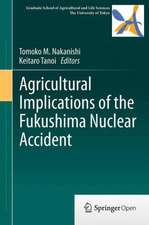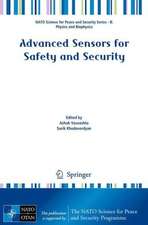Environmental Analysis by Electrochemical Sensors and Biosensors: Applications: Nanostructure Science and Technology
Editat de Ligia Maria Moretto, Kurt Kalcheren Limba Engleză Hardback – noi 2014
| Toate formatele și edițiile | Preț | Express |
|---|---|---|
| Paperback (2) | 843.80 lei 6-8 săpt. | |
| Springer – 23 aug 2016 | 843.80 lei 6-8 săpt. | |
| Springer – 23 aug 2016 | 1171.21 lei 38-44 zile | |
| Hardback (2) | 795.68 lei 6-8 săpt. | |
| Springer – noi 2014 | 795.68 lei 6-8 săpt. | |
| Springer – noi 2014 | 1406.98 lei 6-8 săpt. |
Din seria Nanostructure Science and Technology
- 18%
 Preț: 1114.65 lei
Preț: 1114.65 lei - 18%
 Preț: 1001.02 lei
Preț: 1001.02 lei - 24%
 Preț: 834.57 lei
Preț: 834.57 lei -
 Preț: 405.66 lei
Preț: 405.66 lei -
 Preț: 405.28 lei
Preț: 405.28 lei - 18%
 Preț: 947.35 lei
Preț: 947.35 lei - 18%
 Preț: 734.27 lei
Preț: 734.27 lei - 15%
 Preț: 696.02 lei
Preț: 696.02 lei - 20%
 Preț: 585.29 lei
Preț: 585.29 lei - 20%
 Preț: 556.90 lei
Preț: 556.90 lei - 15%
 Preț: 646.62 lei
Preț: 646.62 lei - 18%
 Preț: 947.50 lei
Preț: 947.50 lei -
 Preț: 397.97 lei
Preț: 397.97 lei -
 Preț: 406.05 lei
Preț: 406.05 lei - 18%
 Preț: 967.08 lei
Preț: 967.08 lei - 18%
 Preț: 947.50 lei
Preț: 947.50 lei - 18%
 Preț: 948.29 lei
Preț: 948.29 lei - 18%
 Preț: 950.03 lei
Preț: 950.03 lei - 18%
 Preț: 951.29 lei
Preț: 951.29 lei - 18%
 Preț: 948.92 lei
Preț: 948.92 lei - 18%
 Preț: 960.13 lei
Preț: 960.13 lei - 19%
 Preț: 559.01 lei
Preț: 559.01 lei - 15%
 Preț: 694.69 lei
Preț: 694.69 lei - 15%
 Preț: 635.15 lei
Preț: 635.15 lei - 15%
 Preț: 640.06 lei
Preț: 640.06 lei - 18%
 Preț: 948.79 lei
Preț: 948.79 lei - 20%
 Preț: 564.27 lei
Preț: 564.27 lei - 20%
 Preț: 628.33 lei
Preț: 628.33 lei - 15%
 Preț: 647.59 lei
Preț: 647.59 lei - 15%
 Preț: 643.16 lei
Preț: 643.16 lei - 15%
 Preț: 643.34 lei
Preț: 643.34 lei - 18%
 Preț: 955.08 lei
Preț: 955.08 lei - 15%
 Preț: 587.72 lei
Preț: 587.72 lei - 15%
 Preț: 649.87 lei
Preț: 649.87 lei - 15%
 Preț: 646.43 lei
Preț: 646.43 lei -
 Preț: 388.72 lei
Preț: 388.72 lei - 18%
 Preț: 955.25 lei
Preț: 955.25 lei - 5%
 Preț: 716.75 lei
Preț: 716.75 lei - 18%
 Preț: 952.89 lei
Preț: 952.89 lei - 18%
 Preț: 1258.46 lei
Preț: 1258.46 lei
Preț: 795.68 lei
Preț vechi: 970.34 lei
-18% Nou
Puncte Express: 1194
Preț estimativ în valută:
152.25€ • 159.39$ • 125.98£
152.25€ • 159.39$ • 125.98£
Carte tipărită la comandă
Livrare economică 05-19 aprilie
Preluare comenzi: 021 569.72.76
Specificații
ISBN-13: 9781493913008
ISBN-10: 149391300X
Pagini: 472
Ilustrații: XIV, 457 p. 93 illus., 28 illus. in color.
Dimensiuni: 155 x 235 x 31 mm
Greutate: 0.84 kg
Ediția:2015
Editura: Springer
Colecția Springer
Seria Nanostructure Science and Technology
Locul publicării:New York, NY, United States
ISBN-10: 149391300X
Pagini: 472
Ilustrații: XIV, 457 p. 93 illus., 28 illus. in color.
Dimensiuni: 155 x 235 x 31 mm
Greutate: 0.84 kg
Ediția:2015
Editura: Springer
Colecția Springer
Seria Nanostructure Science and Technology
Locul publicării:New York, NY, United States
Public țintă
ResearchCuprins
Part 1. Sensors for Measurement of Global Parameters.- Chapter 1. Chemical Oxygen Demand.- Chapter 2. Biochemical Oxygen Demand BOD.- Chapter 3. Total Organic Carbon (TOC).- Chapter 4. Dissolved Oxygen.- Chapter 5. pH Measurements.- Part 2. Sensors and Biosensors for Inorganic Compounds of Environmental Importance.- Chapter 6. Metals.- Chapter 7. Non-Metal Inorganic Ions and Molecules.- Chapter 8. Electroanalysis and Chemical Speciation.- Chapter 9. Nanoparticles-Emerging Contaminants.- Part 3. Sensors and Biosensors for Organic Compounds of Environmental Importance.- Chapter 10. Pharmaceuticals and Personal Care Products.- Chapter 11. Surfactants.- Chapter 12. Determination of Aromatic Hydrocarbons and their Derivatives.- Chapter 13. Explosives.- Chapter 14. Pesticides.- Part 4. Electrochemical Sensors for Gases of Environmental Importance.- Chapter 15. Volatile Organic Compounds–VOC.- Chapter 16. Sulphur Compounds (H2S, S-oxides).- Chapter 17. Ammonia and Nitrogen Oxides.- Chapter 18. Carbon Oxides.- Part 5. Data Treatment of Electrochemical Sensors and Biosensors.- Chapter 19. Data Treatment of Electrochemical Sensors and Biosensors.- Index.
Notă biografică
Ligia Maria Moretto graduated in Chemical Engineering at the Federal University of Rio Grande do Sul, Brazil, and received her PhD in 1994 from the University Ca’ Foscari of Venice with a thesis entitled “Ion-exchange voltammetry for the determination of copper and mercury. Application to seawater.” Her academic career began at the University of Caxias do Sul, Brazil and continued at the Research Institute of Nuclear Energy, Sao Paulo, Brazil. In 1996 she completed the habilitation as researcher in analytical chemistry at the University Ca’ Foscari of Venice. Working at the Laboratory of Electrochemical Sensors, her research field has been the development of electrochemical sensor and biosensors based on modified electrodes, the study of gold arrays and ensembles of nano electrodes, with particular attention to environmental applications. She has published more than 60 papers, several book chapters and has presented about 90 contributions at international conferences, resulting in more than 1100 citations. Prof. Moretto collaborates as invited professor and invited researcher with several institutions in Brazil, France, Argentina, Canada and the USA.
Kurt Kalcher completed his studies at the Karl-Franzens University (KFU) with a dissertation in inorganic chemistry entitled “Contributions to the Chemistry of Cyantrichloride, CINCCI2”; he also received his PhD in 1980 from the same institution. In 1981 he then did postdoctoral work at the Nuclear Research Center in Jülich (Germany) under the supervision of Professor Nürnberg and Dr. Valenta and conducted intensive electroanalytical research while he was there. Prof. Kalcher continued his academic career at KFU with his habilitation on chemically modified carbon paste electrodes in analytical chemistry in 1988. Since then, he has been employed there as an associate professor. His research interests include the development of electrochemical sensors and biosensors for the determination ofinorganic and biological analytes on the basis of carbon paste, screen-printed carbon and boron-doped diamond electrodes, as well as design, automation and data handling with small analytical devices using microprocessors. He has published around 200 papers and has presented about 200 contributions at international conferences. These activities have resulted in more than 3100 citations. Prof. Kalcher has received numerous guest professor position offers in Bosnia-Herzegovina, Poland, Slovenia and Thailand.
Kurt Kalcher completed his studies at the Karl-Franzens University (KFU) with a dissertation in inorganic chemistry entitled “Contributions to the Chemistry of Cyantrichloride, CINCCI2”; he also received his PhD in 1980 from the same institution. In 1981 he then did postdoctoral work at the Nuclear Research Center in Jülich (Germany) under the supervision of Professor Nürnberg and Dr. Valenta and conducted intensive electroanalytical research while he was there. Prof. Kalcher continued his academic career at KFU with his habilitation on chemically modified carbon paste electrodes in analytical chemistry in 1988. Since then, he has been employed there as an associate professor. His research interests include the development of electrochemical sensors and biosensors for the determination ofinorganic and biological analytes on the basis of carbon paste, screen-printed carbon and boron-doped diamond electrodes, as well as design, automation and data handling with small analytical devices using microprocessors. He has published around 200 papers and has presented about 200 contributions at international conferences. These activities have resulted in more than 3100 citations. Prof. Kalcher has received numerous guest professor position offers in Bosnia-Herzegovina, Poland, Slovenia and Thailand.
Textul de pe ultima copertă
Electrochemical sensors represent the oldest type of chemical sensors and are widely present in chemical laboratories, industries, healthcare and in many aspects of our daily life. During the past few decades biosensors mimicking biological receptors for the sake of analytical assessment have emerged as an extremely important and fruitful field in fundamental and applied electroanalytical chemistry. Research and routine analysis in environmental sciences have shown that electrochemical sensors and biosensors may supply useful information for solving problems from the quite general to the highly specific, dealing with environmental pollution or many other questions in connection with (bio)geochemical cycles or fundamental environmental chemical processes. Environmental analytical chemistry is a multidisciplinary field requiring the cooperation of chemists, biochemists, physicists, engineers and many other specialists, a collaboration which defines and guarantees the development and applicability of robust and highly sensitive sensors for chemical analysis and environmental monitoring. The aim of this book is to give an overview of the role of electrochemical sensors in environmental chemical analysis and on their operating principles. It provides detailed information on the applicability of such sensors to the determination of all the different substances of environmental importance. It is designed on one hand as a textbook for students and teachers, and, on the other, as a manual for researchers and applied scientists and engineers who are fully or marginally confronted with problems in context with environmental chemistry. Due to its multidisciplinary character the book synthesizes various viewpoints of different sciences and addresses chemists, physicists, pharmacists, medical doctors, engineers and in fact all who are interested, professionally or non-professionally, in the chemistry of our environment.
Caracteristici
Discusses technological development of sensors for particular analytes Considers practical applications of sensors Discusses new sources of environmental contaminants Covers evaluation of gaseous contaminants Includes supplementary material: sn.pub/extras


























